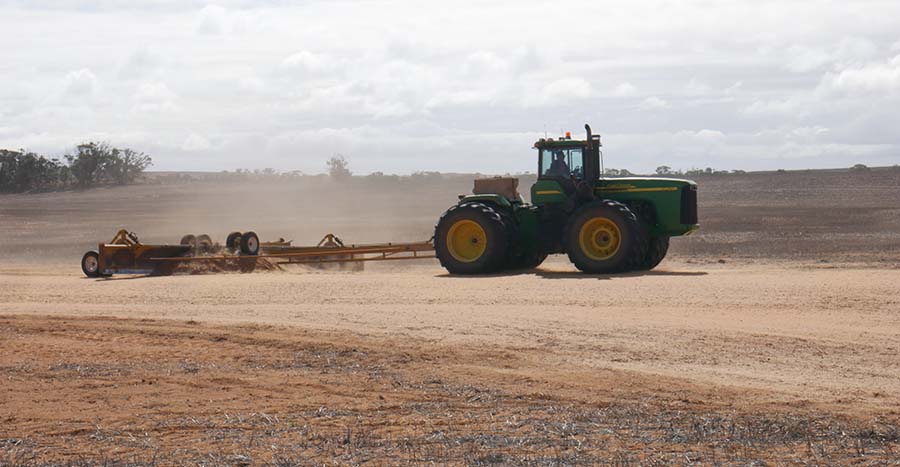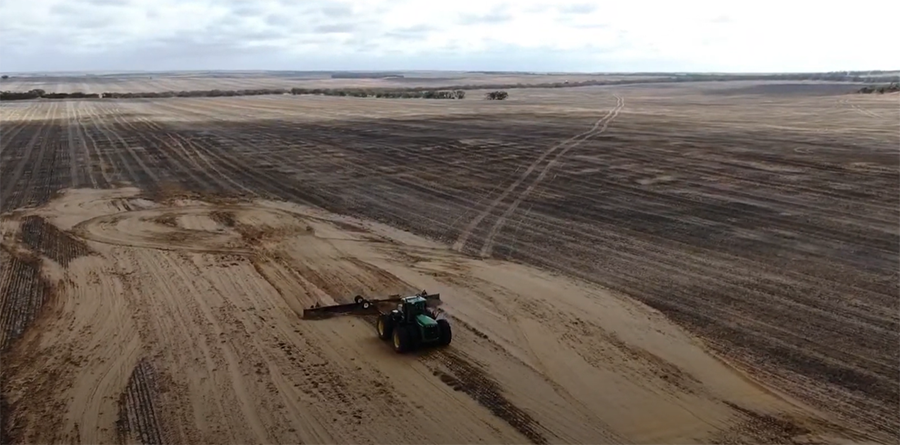Snapshot
Grower: Brenton Schober
Location: South Australian Mallee
Farm size: 5,500 Ha (Moorook) 2,000 Ha (Borrika)
Enterprise: Continuous cropping
Growing season rainfall: 254mm annual (165mm GSR) - Moorook, 310mm Annual (213mm GSR) - Borrika
Soil type: Deep non-wetting sands to sandy loams and heavy flats, and shallow calcareous stony flats
Cropping program: 75% cereal and 25% pulses
Seeding system: No-till farming, Seed Hawk Air Drill, deep knife points and sectional control and variable rate capacity.
Brenton Schober farms with his sons Ben and Clarke and their families. They manage 5500ha at Moorook in the northern Mallee, and 2000ha at Borrika. When the Schobers took over their Borrika property, it was in a severely eroded state.
Across their properties, soil types vary from deep non-wetting sands to sandy loams and heavy flats, and shallow calcareous stony flats, with management of their sands delivering significant system value. The Schobers continuous cropping operation is approximately 75% cereal (wheat and barley) and 25% legume (field peas, chickpeas, vetch, lupins and lentils) managed over a four-year rotation. There is no livestock in the system.
As no-till growers, they sow into standing stubble, use a deep knife point Seed Hawk Air Drill with sectional control and variable rate technology to improve fertiliser application efficiency across their program.
The opportunity to re-level
Between 2018 and 2022, the Schobers have endeavoured to level and re-establish cover over most of their sandy landscapes. Three of these years have received well below average rainfall seasons, especially in 2018, when only 99mm of growing season rainfall was recorded.
The soil levelling processes across the Schobers Borrika property have been gradual, with some areas having established cover and then blowing again because of low rainfall and strong winds. Consequently, re-levelling has been required to enable future seeding and harvest operations to be possible.
Things don’t always go to plan with levelling
Initially, the main program objective was to achieve ground cover right across the farm, which was eventually achieved in 2020. However, some areas remained too uneven to sow and harvest easily. So, the decision was made to re-level and sow paddocks in 2021, despite the lack of rainfall and a late break looming.
“It felt like we were virtually taking it back to day one although we have learnt to keep monitoring and being prepared to resow any areas that may start shifting before they recreate any major erosion issues,” Brenton says.

Ground successfully covered in 2020, although needing re-levelling for ease of ongoing cropping. Photo: Supplied.
Rehabilitation
The process began by using a scraper to get the bulk of the knobs down into the hollows. A landplane was then used to smudge it off. Some topsoil was also re-introduced to increase microbial activity, organic matter and soil fines to surface layers.
Following levelling, the Schobers sowed barley with a high seeding (70kg/ha) and fertiliser rate (75kg/ha 19:13:00:9). In the past, they have also found cross sowing in the most vulnerable areas has proven beneficial in assisting establishment.

Scraper used to initially smooth out lumpy eroded areas. Photo: Supplied.

Landplane used for levelling out eroded hollows and ridges, and lay topsoil back on surface.
The timing of repair
Over time, the Schobers have found repairing and sowing paddocks in April to work well. The soils are warmer, and the crop can get up and established if moisture is available before the damaging winds come. However, when dry sowing, and in years with late breaks and low rainfall, early sowing can be a risk.

Scraper levelling out areas too uneven for seeding and harvesting operations. Photo: Supplied.
The Schobers are no strangers to resowing and closely monitor levelled areas in case resowing is needed, using their 7-foot fruit-blockers disc drill combine, or they even hand sow with a rake to help re-establish cover if required.
Ground cover establishment in 2021 – A decile 1 season
As it turned out, 2021 was a tough year, with the farm receiving only a few 6mm rain events in June and almost no substantial rains for the whole season (decile 1). Yet, the crop grew, establishing enough cover and staying level for harvest and through summer. Two sites monitored by the project showed above 50% cover in December 2021, while a third more challenging site had 37% cover. Brenton was able to sow lupins into these stubbles in 2022 successfully.
After achieving suitable ground cover in 2021 despite a tough season and with a few areas still needing improvement, the Schober’s expect their no-till farming system and good agronomy will maintain enough cover to protect these vulnerable areas from future extended dry periods. There will be no livestock grazing on this property to preserve ground cover.
The Schober's experience
To see more on the Schober’s re-levelling experience as it happened.
Watch the Schobers:

Given the season, a few patches still require repair in 2022.

























































